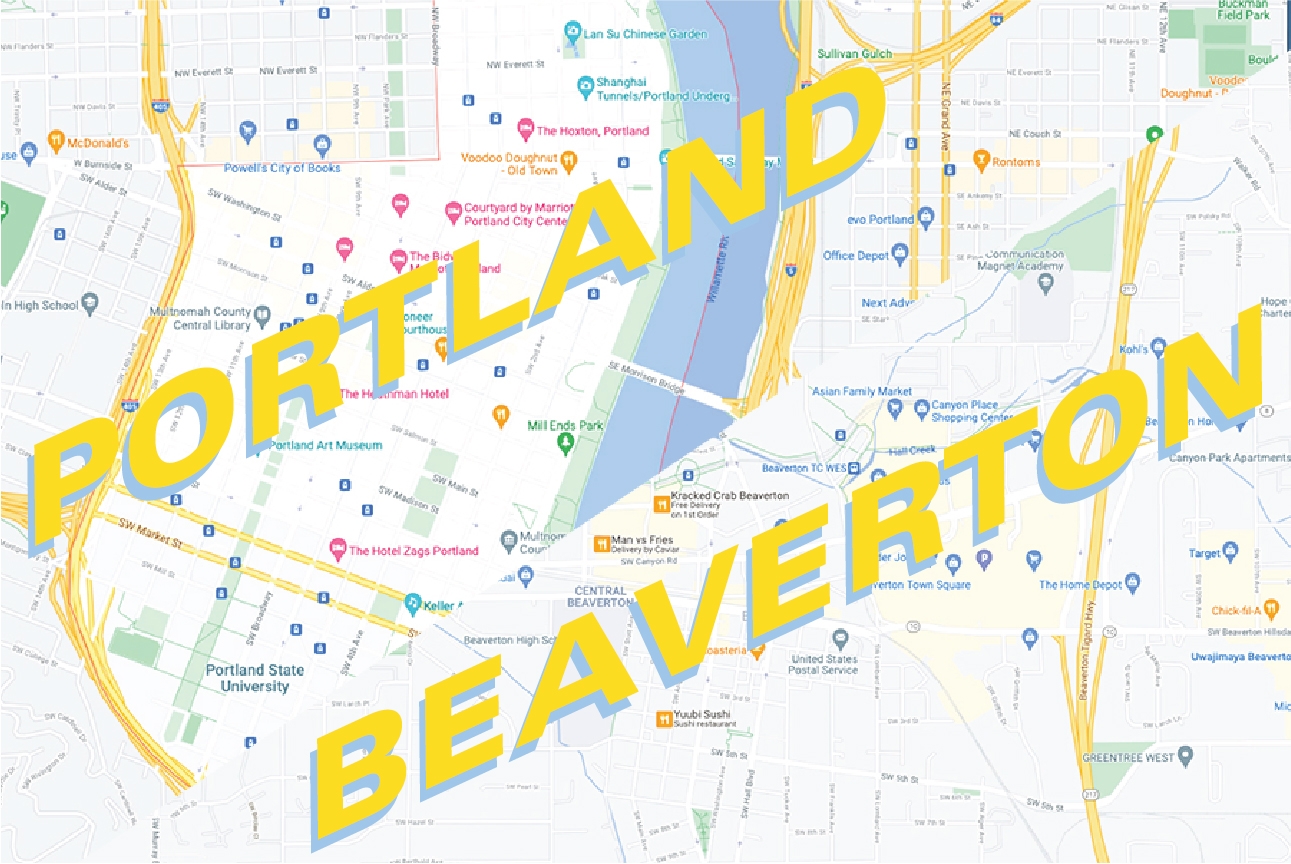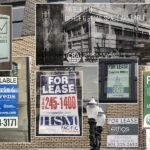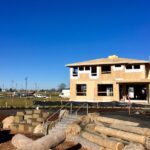As downtown Portland businesses shutter, Beaverton’s Old Town is enjoying a renaissance. Will the west-side suburbs lure businesses for keeps?
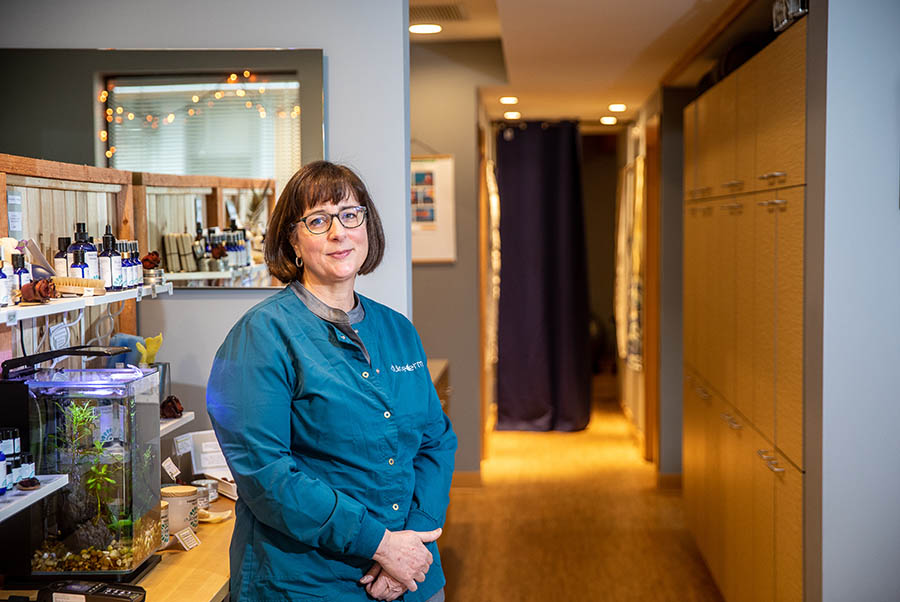 Dulcederm owner Tamara Sullivan in her Beaverton spa. Photo by Jason E. Kaplan
Dulcederm owner Tamara Sullivan in her Beaverton spa. Photo by Jason E. Kaplan
Tamara Sullivan opened Tamara’s Beauty Bar, a skin care and hair removal spa, at the intersection of Southwest Park and Alder in downtown Portland in 2010.
By 2014, she was ready to leave.
On the one hand, she says, was the place to be: busy, vibrant and close to clientele.
But doing business there also presented some challenges. More than once Sullivan discovered human feces in the doorway of her business. But once she discovered who was doing it — a man who was living outdoors in the neighborhood — the two made a deal. She provided cardboard for him to sleep on, and he agreed to do his business elsewhere.
What really made her want to leave had nothing to do with downtown per se.
Instead, she says, a Multnomah County tax code change meant she was suddenly being taxed on her ex-husband’s business income. Sullivan can’t remember the exact details of the change, and Oregon Business was not able to independently confirm the existence of a policy change that would have had this result. She also stresses that her taxes only went up by $200. But that wasn’t the point. The frustration was enough to make her pull up stakes and go to Beaverton.
“It wasn’t a lot of money, but it was more the principle of the thing,” she says.
So Sullivan packed up her storefront on Park and Alder and headed west. She bought a building in downtown Beaverton, remodeled, and opened a new spa, Dulcederm, a year later. Sullivan admits the move cost her a few clients at first, but she kept more than she expected and gained many more. The business experienced exponential growth over the next seven years, with Sullivan eventually hiring seven employees and providing them with perks rarely found in the world of service work: health insurance, paid time off and a 5% match to their 401(k).
Sullivan may have fled Portland looking for tax relief, but she was also riding the wave of a national trend. The number of Americans choosing to live in the suburbs grew by over 10% from 2010 to 2020, according to the U.S. Census and reported by the New York Times.
Downtown Beaverton could be the poster child for that wave. Once considered stodgy and dull, the Portland suburb has done a good job of attracting a young, diverse population. This was not by chance. After investigating the services and amenities needed to attract young office workers, the city engineered a revival of its Old Town, activating a sleepy street into a bustling restaurant row.
The strategy worked. Starting in 2015, Beaverton enticed big-name Portland restaurants — like Big’s Chicken, Afuri Izakaya and Ex Novo Brewing, — to open second locations out in the ‘burbs.
Yet Portland, despite its big-city tax burden and big-city problems of crime and homelessness, remained the star of the show.
Then, in spring 2020, work-from-home protocols and other pandemic-related restrictions emptied business districts everywhere.
Two years later, Beaverton’s downtown revival appears to be COVID-proof. Even during the pandemic, 14 new business concepts managed to open in downtown Beaverton alone, according to Beaverton’s economic development manager, Mike Williams.
But Portland’s Central Business District —that’s a real estate term to define the downtown core — proved far less resilient. One hundred consecutive days of protests, social unrest and bad PR tarnished downtown’s shine. Some national media outlets seized on images from the protest and continue to portray the city’s downtown as a war zone.
“It isn’t,” insists Sullivan, in reference to her old neighborhood.
And really, it isn’t. A recent, very chilly Friday-morning visit to downtown Portland revealed a mixed bag. Some blocks looked OK, with clean streets and numerous storefronts open for grabbing coffee or lunch. Others were empty, with closed businesses and a fair share of tent encampments. Downtown definitely bears the scars of a tumultuous two years, but it is far from a war zone.
Yet aside from patrolling security teams from Downtown Portland Clean & Safe and a dozen or so sneakerheads waiting for the Nike store to open, no one else was around.
So what will it take to bring the crowds back to Portland’s downtown — and what will that mean for the newly hot suburbs?
Coaxing workers back to the office would certainly help. At the start of the pandemic, Oregon saw an additional 211,000 people working from home in 2020 as compared to 2019. Most of those increases were in Portland and the surrounding suburbs according to state economist Josh Lehner. Lehner notes that this spike was a direct response to the pandemic and the need to shelter in place.
Those numbers are falling as companies call staff back to the office, but not quickly enough. Right now, empty offices are taking their toll on Portland’s Central Business District.
Research from the real estate investment firm Colliers suggests those offices will remain empty for some time. Their latest report for the fourth quarter of 2021 shows the amount of office space available in Portland’s downtown market reached 20.1%, up from 17.6% a year ago — a 2.5% increase. The report finds that more than a quarter — 28.8% of Portland’s CBD — is on the market as available. Companies moving out of the Central Business District account for 1.1 million square feet or 4.5% of inventory. This movement is shrinking asking rents down to $33.41 per square foot from $37.94 last year.
Meanwhile, suburban rents are on the rise. The same Colliers report finds that gross asking rents increased 8.1% to $32.12 per square foot. The story is similar for retail storefronts. Williams points to a CoStar report that finds retail vacancy rates are four times higher in the Portland CBD than downtown/Central Beaverton.
Still, many remain bullish on downtown Portland. Georgia Lee Hussey, the CEO of Modernist Financial, sited her politically progressive wealth management company in the Union Bank Tower on Washington and Broadway in 2015 because of its then-vibrant downtown surroundings. As a B-Corporation, proximity to public transportation was an important driver in picking the address. The location was also a lifestyle choice for the former artist.
“I live in the Pearl District, so this is a 12-minute walk for me,” she says.
Hussey is acutely aware of downtown Portland’s reputation. For her part, she’s loud and proud about those endless nights of protests following the killing of George Floyd.
“They were the messy work of social change,” she says. “People came out for 100 days to say that killing an unarmed Black man is not OK.”
Hussey talks to her clients about reparations and frames taxes as less of an individual burden and more about collective benefits. (Those clients, by the way, must have at least $1 million in investible assets or pay a $17,500 annual fee to work with Modernist.) The strategy appears to be working. This last pandemic year was a busy one for Modernist, with the company growing by 60%. And yes, all employees are back in the office, although Hussey admits they are trying a hybrid with people working from home one or two days a week.
With her lease coming due, Hussey is considering a move but not out of the downtown core. With rents declining, she will probably find a deal. Others, perhaps those previously priced out of the CBD, may also be inspired to move downtown.
That kind of movement is a dream for Sara Daley, a senior associate broker at NAI Elliott, a commercial real estate firm headquartered in Portland. She sees a real change in her clients currently located in urban neighborhoods, a shift from not understanding the suburbs to actively seeking these locations.
In a video on the NAI Elliott website, Daley says, “Some players who used to be the highest competitors for space downtown are putting their attention elsewhere.”
When asked who these players are, she is quick to respond.
“Kurt Huffman.”
And it’s true that the owner of ChefStable — a group that partners with chefs to design, build and operate restaurants — has gone in big for the suburbs. He recently built out a six-restaurant cluster in Lake Oswego’s Mercato Grove, one of the region’s hottest areas. Huffman also brought a second location of the Loyal Legion taphouse to downtown Beaverton.
Meanwhile, Chez Agnez, a downtown ChefStable property, closed earlier this year. It joins other downtown darlings, like Shift Drinks and Clyde Common, that have shuttered in response to the pandemic.
Daley sees this outmigration as an opportunity, a chance for a different community of people who are ready to invest in downtown Portland and double-down on new concepts and fresh ideas.
“My dream is for a new, more diverse group of players to come downtown,” she says. “But there is still a long way to go.”
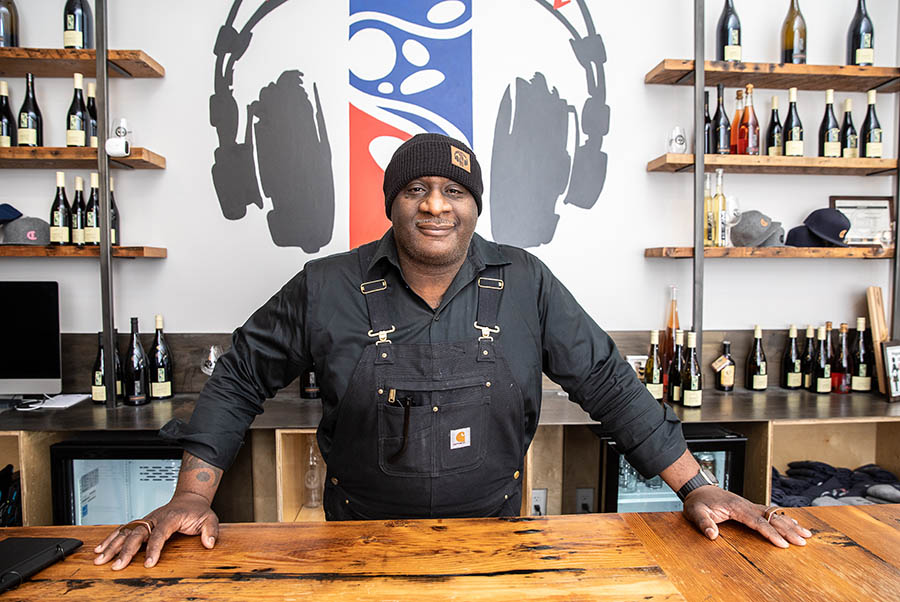 Abbey Creek Vineyard founder and owner, Bertony Faustin, at his downtown Portland tasting room, the Crick PDX. Photo by Jason E. Kaplan
Abbey Creek Vineyard founder and owner, Bertony Faustin, at his downtown Portland tasting room, the Crick PDX. Photo by Jason E. Kaplan
One player has taken that first step and set up shop in Portland’s Central Business District. Bertony Faustin, founder and owner of Abbey Creek Vineyard and Winery, opened his new tasting room, the Crick PDX, on Southwest Morrison Street between 9th and 10th in 2020. An extension of his North Plains winery, the Crick PDX — branded as a hip-hop wine bar — was the first tenant in the space. The journey has been bumpy, even for the preternaturally positive Faustin, who has received national press as Oregon’s first Black winemaker.
“In the midst of the pandemic and tons of businesses being boarded and closing in 2020, I saw an opportunity to provide the city and all of our followers a bit of light amongst all of the dark times we were experiencing,” he tells OB via email. “Being the first tenant in that space, I would get daily visitors that would come in just to say thank you for being open and vowing to come back as restrictions would be lifted.”
Faustin admits that business has been affected by Portland’s rising unhoused population, graffiti, vandalism and other safety issues that continue to define the downtown core. Still, he’s comfortable with his sales numbers. He’s also happy with his landlord, who “hired a private security firm, which helps having a consistent presence for the safety of our staff and patrons” and “has been supportive [in] finding ways to make these unprecedented times a win-win for both of us financially.”
But the Crick PDX is not performing as well as Faustin originally hoped.
“All of our projections were based off of pre-COVID data, so [the numbers] are not close to where I’d want them to be,” he writes.
Faustin is not alone. The Portland Business Alliance’s State of the Economy Report, released in mid-February, lays out downtown’s sluggish recovery in stark terms. Foot traffic in November 2021 was down more than 40% as compared to pre-pandemic times. Visitor traffic, an important demographic for Portland, remains down by 30% or more.
The report suggests a reason for this trend. “The findings deserve more examination but are consistent with a hypothesis that the federal government’s interventions in July 2020, and associated protests, have suppressed activity in Portland’s downtown core.”
Business owners, however, point to different reasons for the downturn, according to the most recent Downtown Portland Business Survey conducted by the Downtown Portland Clean & Safe District, a 40-year-old program formed to provide security guards, litter cleanup and sidewalk cleaning for the district. Most who responded to that survey — 68% — feel the city is unsafe, pointing to increased homelessness, more vandalism and decreased cleanliness.
Actual crime statistics from the Portland Police Bureau’s records for the Downtown Retail Council, the bureau’s name for the Central Business District, tell a more nuanced story. There was a sharp spike in crime in June 2020, with 1,141 reported incidents. Disorderly conduct and vandalism were the most common offenses. But by December 2021, reported incidents slipped to 441. The two most common crimes that month were car prowling, which includes the larceny offenses of theft from a motor vehicle or theft of a car part, and vandalism.
It is hard to compare these numbers to downtown Beaverton, in part because the suburban city is much smaller — with 97,494 people compared to Portland’s 652,503 according to 2020 Census data. Plus, the two jurisdictions do not track crime in the same way. For example, downtown Beaverton sits in what the Beaverton Police Department calls the Central Beaverton neighborhood. But that Central Beaverton neighborhood sprawls far beyond downtown.
Given that, crime statistics for the Central Beaverton neighborhood look stable over the past three years. Total offenses peaked in 2020 at 3,339 reported incidents but retreated to 3,162 in 2021. Interestingly, the number of businesses reporting burglaries continues to rise from 29 in 2019 to 43 in 2020 to 47 in 2021.
But regardless of what the data shows, the narrative remains: Downtown Portland is not a safe place to do business, and the suburbs are.
Solutions to Portland’s crime, vandalism and homelessness challenges are high on Tamara Goldsmith’s wish list. As owner of Redux Boutique and Gallery on East Burnside — which is outside the Central Business District and what most would consider Portland’s downtown, but solidly inside the urban core — Goldsmith grew her shop from a small studio for making custom jewelry to a gift store stocked with a mix of locally made and imported products.
“A lot of my customers were guests at the Jupiter Hotel or diners who ate at Le Pigeon the night before, saw our storefront and came back when we were open,” she says.
Always a labor of love, Redux was never a financial powerhouse. But it was successful enough to sustain itself and make payroll for four part-time employees. However, things began to change in 2016. Goldsmith noticed more crime, more drug use, and an angrier, more aggressive homeless population.
“I had to shift my training,” she says, “from how to explain the difference between gold fill and gold plate to how to handle a person who comes in and starts breaking things. We small-business owners feel like we are on the frontlines.”
Fallout from the pandemic intensified her pain. Employees kept quitting because they felt unsafe, so Goldsmith cut hours of operation back enough to run the business single-handedly. She’s presently sharing the space with another sole proprietor, Daphne’s Botanicals, which was looking for a brick-and-mortar location to support its online business. Goldsmith hopes to find one more business to round out her offerings.
With her lease expiring in 2023, Goldsmith is not sure if she will keep the business going. Other small business owners like her are also rethinking plans. The Downtown Portland Business Survey found that almost 40% of business owners currently located in the downtown core plan to relocate. A whopping 80% do not plan to relocate within downtown Portland.
But Goldsmith would rather shutter Redux for good than move it to the suburbs.
“I’m in Portland for the music, culture and art of a city location,” she says. “I just don’t see myself finding satisfaction in the suburbs.”
That mindset drove some west-side tech firms, like programmable-chip company Lattice Semiconductor, out of the suburbs and into downtown Portland in 2015. But just four years later, Lattice moved back to the west-side suburbs. They were joined by Standard Insurance in 2020. KinderCare and Umpqua Bank left the urban core in favor of Lake Oswego’s Kruse Way corridor one year later.
While the suburban west-side office and retail market remains hot, real estate’s big winner is industrial. Born from our pandemic shopping habits, which moved from in-person to online seemingly overnight, and supplychain disruptions that revealed the need to stock supplies closer to home, the region finds itself in short supply of infrastructure like warehouses, fulfillment centers and the like.
“There’s even a company that just handles returns and broken items,” reveals Mike Thomas, senior vice president at Colliers International.
As successful as this last year has been, the suburban west side appears to be facing a reckoning of its own. Beaverton’s Williams notes that rising rents and low vacancies may make it more difficult for existing businesses to hold on. The city has answered with more than $6 million in business assistance since the beginning of the pandemic.
But the most pressing issue on the minds of west-side real estate professionals is Intel, and its recent $20 billion investment in Ohio. The chip maker, Oregon’s largest private employer, didn’t even consider the state for its two new megafabs because of the region’s lack of available land.
The decision troubles Thomas.
“Intel is the anchor tenant for the state of Oregon,” he says, “and we don’t have a large enough parcel of land for our own anchor tenant.”
While the Intel story continues to play out, the city of Portland has taken some positive steps to shake downtown out of its doldrums. An entire slate of summer events was announced, including open-air concerts in Pioneer Courthouse Square. The news has bolstered Jared Mees, co-founder and CEO of record label/local art and craft emporium Tender Loving Empire.
“I see a lot of energy welling up down there, and I believe summer 2022 will be a big turning point for downtown,” he says via email. Mees also admits that his downtown location has taken a bigger hit than others, including one in Tigard’s Bridgeport Village. But he has no plans to pull up stakes.
“Tender Loving Empire has been downtown for 12 years,” he writes. “We’ve seen a lot of changes in that time, and I expect we’ll see more change over the next 12 years. We aren’t going anywhere.”

